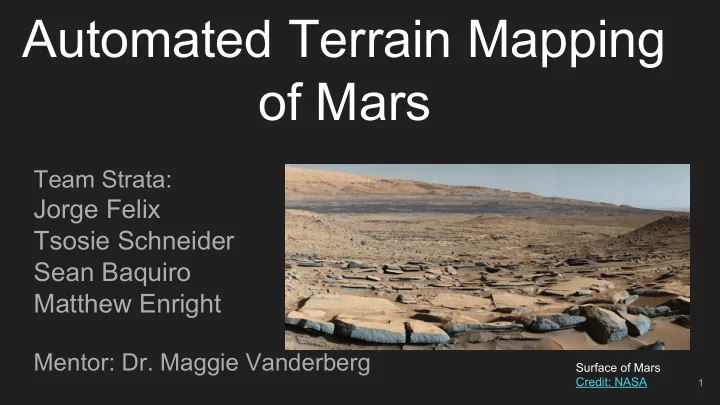

Automated Terrain Mapping of Mars Team Strata: Jorge Felix Tsosie Schneider Sean Baquiro Matthew Enright Mentor: Dr. Maggie Vanderberg Surface of Mars Credit: NASA 1
Our Sponsor Dr. Ryan Anderson ● Physical Scientist SuperCam Project Credit ● Research on Gale Crater NASA ● Geologic Mapping and Characterization of Mars USGS Astrogeology Science Center ● Innovative research on planetary cartography ● Develop software of planetary remote Sensing data 2
Problem Statement ● An efficient approach to mapping terrains ● Manual Method occurs by hand ○ Time consuming ○ Inefficient ○ Inconsistent Manually Mapped Image Credit: Mars Journal 3
Importance ● History of Mars through geological processes ● Learn about planet’s formation ● Produce regional maps for potential landing sites ● NASA proposal Dark Toned Dunes Credit NASA 4
Existing Solutions? ● No reliable automated terrain mapping algorithms ● Tool developed in U of A ○ Used a Convolutional Neural Network ○ Automated detection of impact craters on Mars Credit: L. F. Palafox1 , A. M. Alvarez2 , C.W. Hamilton1 , Lunar and Planetary Laboratory, University of Arizona 5
Solution Overview ● Load JP2 images for analysis ● Train the Neural Network ● Produce annotated JP2 with marked terrains ● Simple command line interface Credit: Mars Journal 6
Functional Requirements ● HiRISE will provide high resolution images and CTX will provide context images of Mars’ surface CTX 7 Credit: NASA/JPL/University of Arizona HiRISE
Functional Requirements ● Load and georeference multiple data sets ● Identify terrain types and features ● Map features across multiple input images Credit: Ryan Anderson 8
Functional Requirements ● CNN’s take advantage of the fact that the input consists of images and they constrain the architecture in a more sensible way. Classic Neural Network Convolutional Neural Network Credit: Stanford University 9
Development Methodology ● Agile Development Process (Scrum) ● Weekly meetings ● Waffle.io 10 Waffle.io
Hybrid Architecture 11
Architecture Dataflow 12
Architecture Dataflow 13
Architecture Dataflow 14
Implementation 15
Implementation 1.1 JP2 image processing 1.2 Image data extraction 1.3 C++/Python Integration 1.4 Training image data processing Test image (left) Training image (right) 16
Implementation Pre-processing image data extraction output ● blue band = original test data ● green band = training data 17
Implementation 1.5 Neural Network Training ● Create ● Train ● Predict Convolutional Neural Network 18
Implementation 1.5 Neural Network Training ● Create ● Train ● Predict Network Training Output 19
Implementation 1.5 Neural Network Training ● Create ● Train ● Predict Prediction output generated 20
Implementation 1.6 Output data processing 1.1 JP2 image processing 1.2 Image data extraction 1.3 C++/Python Integration 1.4 Training image data processing Mapped JP2 Image (features in white) 21
Testing ● Unit Testing ● Cross validation ● Usability testing 22
Unit Testing ● PyUnit framework ○ Image processing functions ○ Neural network creation functions ○ Python helper functions 23
10-fold Cross Validation ● 10-Fold Cross Validation ○ Divided data into 10 sets Example 5-fold cross validation ○ Train on 9 sets ○ Validate on 1 ○ Detect and prevent overfitting 24
Usability Testing ● User study on console interface Dr. Ryan Anderson Credit: USGS 25
Challenges and Risks Challenges ● Installation problems (Boost, Theano, Lasagne) ● Lack of physical memory Risks ● Higher end machine requirement poses a risk for users with older machines. 26
Conclusion ● Automating the annotation process ● Taking in an orbital data set with a terrain type of interest ● Applying a Neural Network ● Produce results as a color- coded image Credit: Mars Journal 27
Questions? 28
Recommend
More recommend